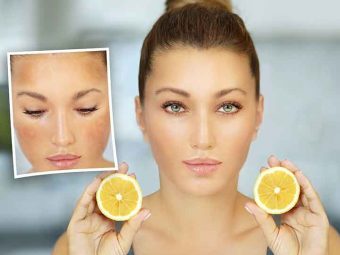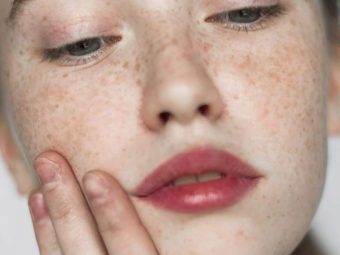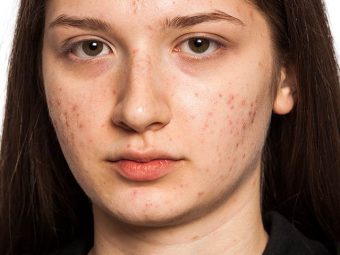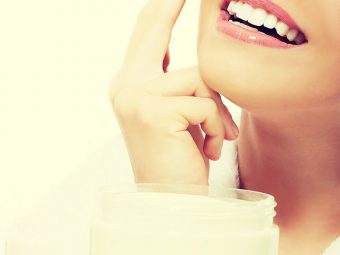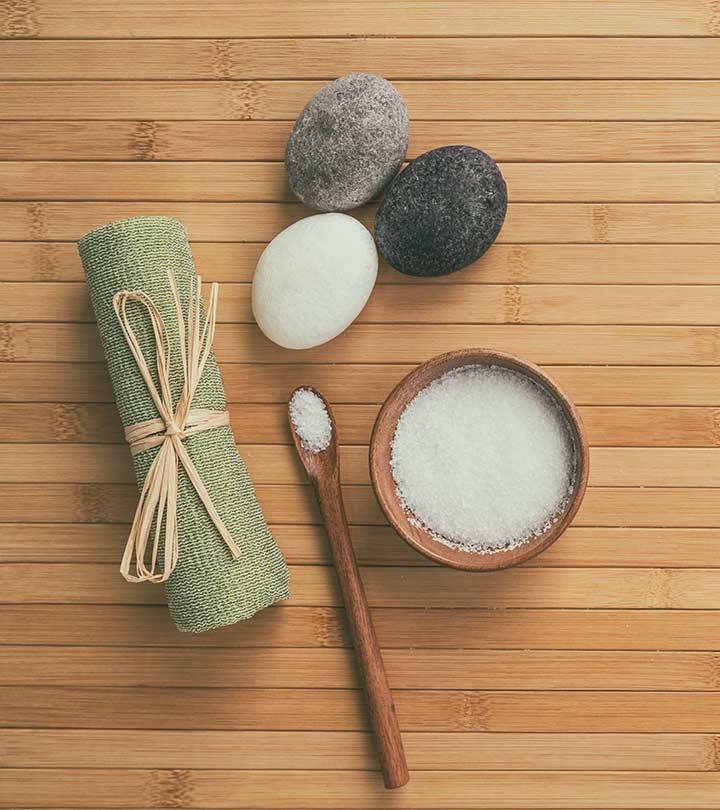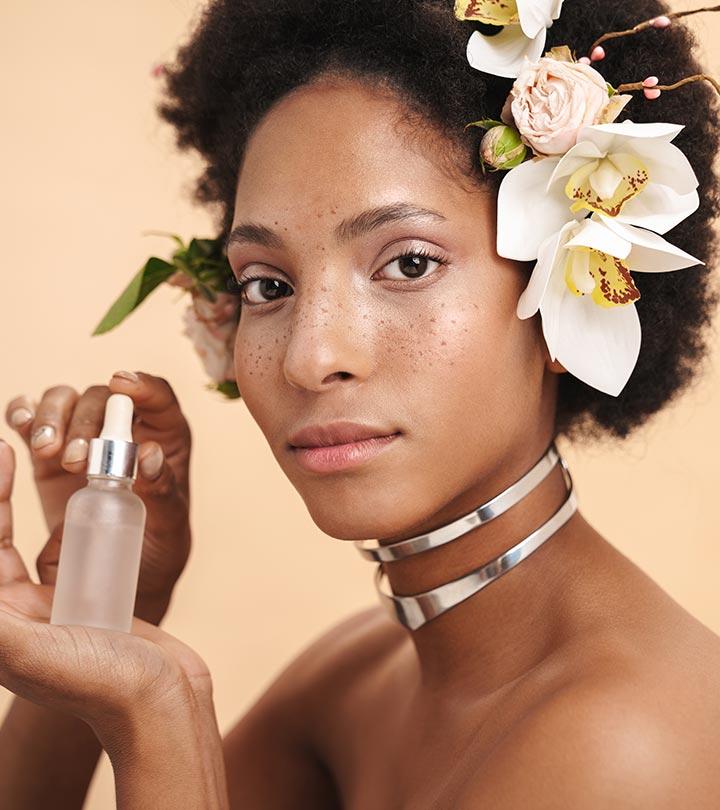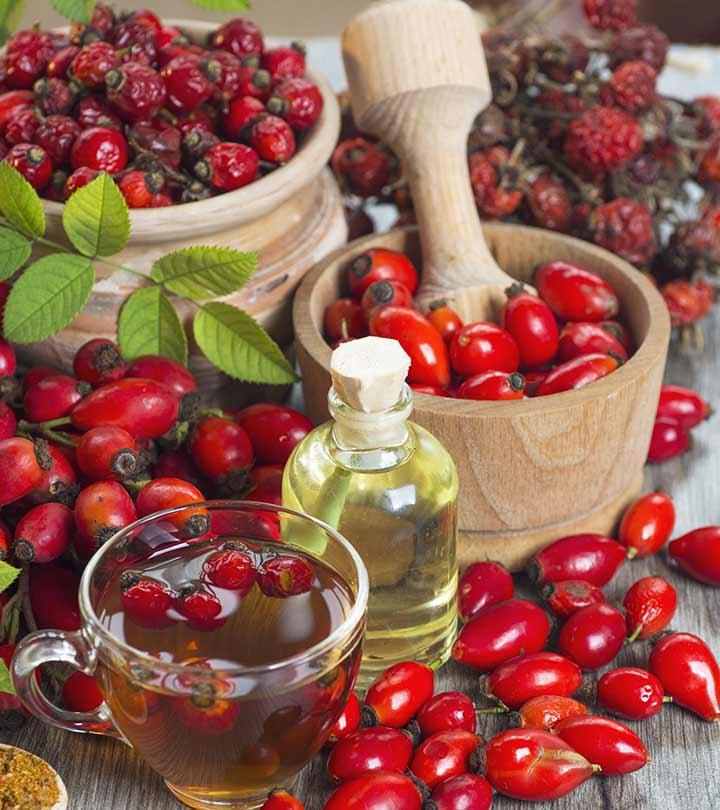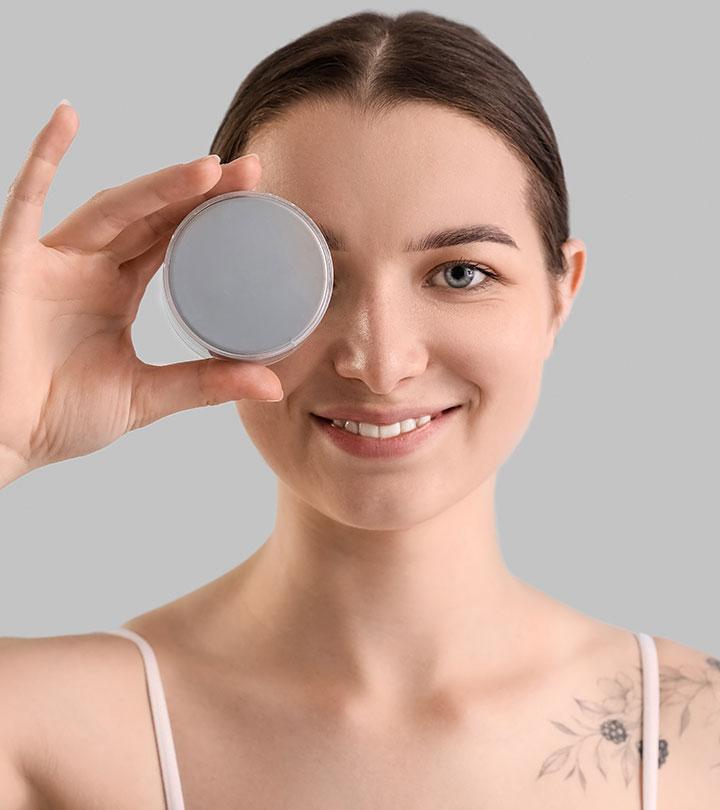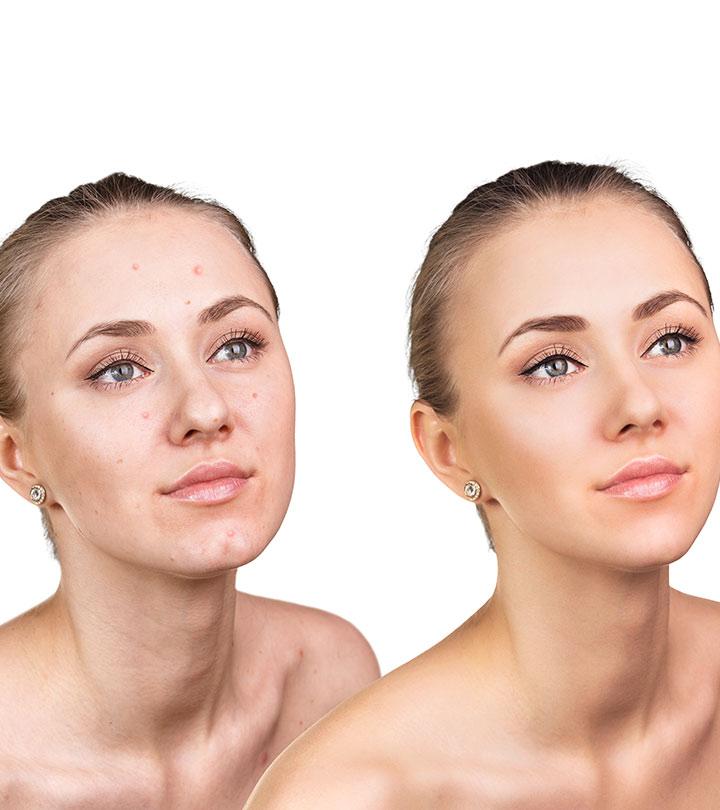10 Best Home Remedies For Sunspots, Causes, And Treatments
The best and most effective tips to minimize sunspots with home remedies.

Image: Shutterstock
Many people avoid going into the sun because they are afraid of sunspots appearing on their skin. Right now, you are probably thinking about how to get rid of sunspots. Don’t worry! We have got your back. Many people are concerned about sunspots. They are also hard to conceal if you don’t use makeup. Although these flat, brown patches are not hazardous, they can disrupt your appearance. This post is for you if you are looking for the best sun protection strategies and effective ways to get rid of sunspots. We have explored the underlying cause of sunspots, as well as some natural remedies and the finest sunspot removal methods, in this article. Check it out!
In This Article
What Are Sunspots? What Causes Them?
Sunspots are flat brown spots on your skin. They are hyperpigmented skin blemishes and are also known as solar lentigines. This kind of skin discoloration could be a result of sun exposure for long periods. The harsh ultraviolet rays from the sun can multiply the pigment cells (melanocytes), which results in sunspots. Overactivity of tyrosinase (an enzyme responsible for melanin production) may cause irregular activity of melanocytes resulting in sunspots. Also, some people may develop these spots due to hereditary problems (1). They can appear on any section of your body that is exposed to the sun. It could be your cheeks, nose, upper lip, ears, arms, and hands.
Home remedies are, by far, the smartest and cheapest way to fight skin problems like sunspots. Remember those face packs and concoctions carefully selected by your mother? They really do work! Following are the ways in which you can get rid of sunspots with home remedies.
Home Remedies For Sunspots
1. Aloe Vera
You Will Need
Fresh aloe vera gel or aloe juice
What You Have To Do
- Extract fresh gel from an aloe leaf and apply it to the affected area.
- Leave it on for half an hour and then wash it off.
How Often You Should Do This
Do this every day.
Why This Works
Aloe vera contains natural healing agents that lighten dark spots and other signs of sun damage on the skin. It aids skin regeneration and improves skin quality (2). Aloe vera also exhibits antityrosinase activity that helps remove sunspots (3). Moreover, it contains two active compounds – aloesin and aloin – that help in removing sunspots and lightening hyperpigmentation (4), (5), (6).
 Quick Tip
Quick Tip2. Lemon
You Will Need
- A lemon
- 1/4 cup of water
- Cotton ball
What You Have To Do
- Squeeze out the fresh lemon juice.
- Leave it on for 20-30 minutes.
- Wash it off with cool water.
- Pat your face dry and apply a good moisturizer.
Caution: Undiluted lemon juice is highly acidic and may cause damage to the skin, especially if it is prone to be sensitive.
Alternate Method
- Mix a tablespoon of sugar with a tablespoon of lemon juice.
- Use this mixture as a scrub on the sunspots.
- After scrubbing for a minute or two, leave the mixture on for about 10 minutes. Rinse it off with water.
How Often You Should Do This
Use the simple lemon juice remedy every day. The lemon-sugar scrub can be used 2-3 times a week.
Why This Works
Lemon has bleaching properties that may help reduce the appearance of sunspots (7). It also helps you attain a flawless and radiant look.
3. Apple Cider Vinegar
You Will Need
- 1 tablespoon apple cider vinegar
- 4 tablespoons water
- 1 teaspoon honey
What You Have To Do
- Mix the ingredients and apply the mixture to the skin.
- Keep it on for at least 10 minutes, and then wash it off.
- Add some orange juice to this mix for better and faster results.
How Often You Should Do This
Do this once a day to maximize results.
Why This Works
Apple cider vinegar is beneficial for different skin problems, including sunspots. The acetic acid in ACV can decrease melanin deposition (2). Thus, it may help reduce sunspots.
4. Green Tea
You Will Need
- A green tea bag
- A cup of hot water
What You Have To Do
- Place the teabag in a cup of water for 10 minutes.
- Remove the teabag, let it cool down, and place it on the affected area. Alternatively, you can apply the green tea you prepared once it has cooled down on your sunspots.
How Often You Should Do This
Do this once or twice daily.
Why This Works
Green tea is known as a powerhouse of antioxidants that fight skin conditions like tanning and spots (8). It also has a depigmenting effect that may help treat sunspots (9).
5. Castor Oil
You Will Need
A few drops of castor oil
What You Have To Do
- Apply the oil on the affected area and massage it in for a few minutes.
- Leave it on for at least an hour before rinsing it off.
How Often You Should Do This
Repeat this once or twice daily.
Why This Works
Castor oil deeply nourishes your skin as it contains essential fatty acids. It also helps lighten hyperpigmented skin (10).
6. Besan (Gram Flour)
You Will Need
- 2 tablespoons besan
- A pinch of turmeric powder
- 1 teaspoon lemon juice
- 1 teaspoon milk
What You Have To Do
- Make a paste by mixing all the ingredients.
- Apply this pack all over your face and keep it on for 15 minutes.
- Rinse it off with cool water.
- If you are allergic to dairy, use rose water instead of milk.
How Often You Should Do This
Repeat this 2-3 times a week.
Why This Works
Besan (gram flour) lightens the skin tone, reduces tan, and exfoliates the skin (11). Milk contains lactic acid that acts as an exfoliator, while lemon brightens your skin (7).
7. Buttermilk
You Will Need
- 1-2 tablespoons buttermilk
- Cotton ball
What You Have To Do
- Simply dip a cotton ball into a bowl of buttermilk and massage it all over the affected area.
- Leave it on for 10 minutes, and then rinse it off.
How Often You Should Do This
Do this twice a day to reap the benefits.
Why This Works
Buttermilk has a soothing effect on the skin. It is also claimed to have a bleaching effect which may help lighten sunspots. However, there is no scientific evidence to prove the same.
 Quick Tip
Quick Tip8. Papaya Pulp
You Will Need
2-3 cubes of ripe papaya
What You Have To Do
- Mash the papaya and apply the pulp to the affected area.
- Leave it on for 10-12 minutes.
- Wash the area using cool water.
How Often You Should Do This
Apply papaya pulp twice a week.
Why This Works
Papaya can exfoliate the skin and make it lighter (12). It may help reduce pigmentation, sunspots, and scars.
9. Fuller’s Earth
You Will Need
- 2 tablespoons Fuller’s earth
- 1 tablespoon aloe vera gel
- Rosewater
What You Have To Do
- Make a paste of medium consistency by adding enough rose water to the Fuller’s earth powder and aloe gel.
- Apply this mixture to the affected area and let it sit for 15-20 minutes.
- Wash the face pack off with cool water.
How Often You Should Do This
Apply this pack 2-3 times a week.
Why This Works
Fuller’s earth is also known as Multani mitti. It is commonly used for brightening your skin. It also improves blood circulation to the skin’s surface, unclogs pores, and removes the dull layer of skin cells (13). Rose water helps reduce skin redness (14). Also, it may help hydrate your skin.
10. Sandalwood
You Will Need
- 2 tablespoons sandalwood powder
- 1 tablespoon lemon juice
- Rosewater
What You Have To Do
- Mix some rose water with the sandalwood powder and lemon juice to get a face pack consistency.
- Apply this all over the sunspots and let it dry for 10-15 minutes.
- Rinse it off with water.
Another way to use sandalwood for sunspots is to blend sandalwood oil and olive oil in a 1:2 proportion and apply it every night on the sunspots.
How Often You Should Do This
Use this pack twice a week.
Why This Works
Sandalwood may help reduce skin dullness and eliminate hyperpigmentation (15).
Listed below are some more home remedies and medications you can use to treat sunspots.
Other Home Remedies For Sunspots
- Licorice Extract: Licorice extract has been used in traditional Chinese medicine for its benefits. The glabridin in licorice extract exhibits antityrosinase activity, which helps prevent UVB-induced pigmentation. It removes epidermal melanin and inhibits the biosynthesis of melanin (2).
- Red Onion: The dried skin of red onions is said to exert antityrosinase activity and has skin-whitening properties (16).
- Vitamin E: Topical application of vitamin E can reduce photo-induced skin damage (17). Thus, applying vitamin E oil may help lighten sunspots.
- Over-The-Counter Creams: There are many topical creams available that you can use to remove sunspots. Most of these creams work by targeting the tyrosine enzyme to reduce the appearance of sunspots. Always look for topical creams that contain hydroquinone, glycolic acidi XA natural water-soluble compound used in skin care products for exfoliation that is largely obtained from sugar cane. , hydroxy acidi XBelongs to a class of organic compounds derived from living organisms that are used in skincare to smooth fine lines and wrinkles. , or kojic acid.
- Hydroquinone: Hydroquinone cream works as a skin-lightening agent and standard depigmentation treatment by inhibiting the effect of tyrosinase (18). Hydroquinone is available at 2% concentration over the counter or at 4% concentration in prescribed creams. Topical application of hydroquinone poses no risks. However, pregnant and breastfeeding women should avoid using hydroquinone because substantial amounts of the medication are absorbed into the skin.
- Tretinoin: Tretinoin cream is frequently prescribed by dermatologists to repair and reverse sun-damaged skin. It is a derivative of vitamin A that works by lightening the skin. Topical application of tretinoin cream has been found to improve the appearance of sun-damaged skin (19).
- Tri-Luma: Tri-Luma is another topical cream used for treating sunspots. It contains three active ingredients – hydroquinone, tretinoin, and fluocinolone acetonide – in its formulation (20). It has been found that the potency of hydroquinone increases with the addition of tretinoin (21).
- Azelaic Acid: It is a naturally derived grain-based acid that effectively diminishes sunspots, hyperpigmentation, and uneven skin tone. It promotes a clearer skin tone by impeding melanin production and facilitating gentle skin exfoliation. Studies on mice indicate that concentrated azelaic acid could potentially inhibit melanoma cells and reduce the resulting pigmentation (22).
- Vitamin C: It is a potent antioxidant that helps diminish sunspots, hyperpigmentation, and other skin discolorations (23). Regular application of vitamin C serums or creams may reduce melanin production, promote an even skin tone, and protect against further sun damage. Its brightening properties make it a valuable addition to a skin care routine for sunspots.
Fluocinolone acetonide is a corticosteroid that is used to treat severe inflammatory skin disorders (24).
These are some of the at-home remedies to get rid of sunspots. There are a few sunspot removal treatments available, but these should be performed by a trained skin care professional. Let’s learn more about those professional treatments in the following section.
What Are The Best Sunspot Removal Treatments?
If you want faster methods of treating sun-damaged skin, there are several treatment options in dermatology that you can consider. We have discussed them below.
1. Laser Skin Resurfacing
Laser skin resurfacing is a skin care procedure that helps improve skin texture and reduces blemishes, acne scars, and skin irregularities. This procedure involves a wand-like device that is used to deliver laser beams to the skin. This device removes sun-damaged skin layer by layer. The entire laser treatment process can take a minimum of 30 minutes to 2 hours for sunspot removal. Healing of the skin can take anywhere from 10 to 21 days.
2. Intense Pulse Light (IPL)
Intense pulse light uses pulses of light energy to target dark spots on the skin. Lasers of different wavelengths are used to heat the pigmented cells, thereby removing the sunspots by destroying the melanin. It is also known as a photo facial, and it takes less than 30 minutes. It can treat several skin conditions, and the number of sessions required varies from person to person. Also, it causes little to no pain.
3. Chemical Peels
Chemical peel is another cosmetic procedure that involves the application of an acid solution to your skin. It causes your skin to exfoliate the damaged skin cells and make way for new skin. The main idea behind this procedure is to encourage your skin to shed off its damaged outer layer and reveal newer skin underneath. It helps reduce sunspots, wrinkles, and fine lines. It can make your skin firmer, brighter, and healthier.
Chemical peel treatment also encourages collagen production. This process reduces uneven skin tone and acne scars. The recovery time for a chemical peel is 1-4 weeks depending on the depth of the peel. Light/superficial peels penetrate and act on the epidermis, the outermost layers of the skin. Whereas medium/deep grade peels go much deeper by penetrating the dermis at various levels depending on the concentration and application time. This treatment may be more painful than the others, but it has decades of data that shows the best results for an even skin tone. Besides some pain, it can cause a burning sensation that lasts a few minutes. You can treat these side effects by using over-the-counter creams.
4. Cryotherapy
Cryotherapy is also known as cold therapy. In this treatment, skin lesions are exposed to extremely cold temperatures. This process helps reduce sunspots. Using nitrous oxide is the best option for the treatment of dark spots (25). This process only takes a few minutes.
Joanna, a Youtuber, shared her experience of using cryotherapy to remove sunspots. She shared that her dermatologist used liquid nitrogen to fade the dark spots on her face. She adds, “After 2 months, when the redness started going away and the scare had healed, you can see the dark spots have dramatically faded a lot compared to the original form (i).”
5. Microdermabrasion
Microdermabrasion is a cosmetic procedure that involves the exfoliation of the top layer of the skin. This process uses a small hand-held device with an abrasive surface. The special applicator with an abrasive tip removes the outermost layer of the skin, followed by suction to remove the dead skin. It can reduce age spots, wrinkles, fine lines, melasmai XA common skin condition that causes brown patches to appear on the skin, most commonly due to exposure to the sun and hormonal changes. , and acne scars. This is a very effective, painless procedure for many skin aging concerns and takes about one hour. You may experience some temporary redness and tightness after the procedure.
6. Microneedling
Microneedling is a minimally invasive derma roller procedure that uses hundreds of small needles to create ‘micro-injuries’ in the skin. This signals your body to produce more collagen and elastini XThe most abundantly found protein in the body that is responsible for the elastic recoil of the skin and helps organs stretch and contract. to repair the affected area. It is mostly used on the face, but can be used on the body to reduce stretch marks or scars. It also helps in the absorption of topical serums that contain skin lightening ingredients. This makes derma rolling a great option for treating sunspots, wrinkles, pigmentation marks and acne scars. A topical anesthetic may be applied prior to the process to help reduce discomfort.
These are the different professional treatments for sunspots. Here are some more tips to keep in mind to avoid sunspots.
Tips For Sunspots
1. Try Anti-Tan Facials
A good anti-tan facial can help you fight sun spots and pigmentation. You can use an at-home anti-tan facial kit or get it done by a professional at a spa, salon, or skin clinic.
2. Stay Away From The Sun
Try not to step out in the sun too much if you are already tanned. Even if you are, it is best to carry an umbrella. Also, remember to wear loose-fitting clothes. Don’t go for dark or bright colors. The simpler your clothing, the better it is for your skin. Wear sunglasses to protect your eyes. If you are at the beach, don’t forget your hat.
3. Use Sunscreen
Sunscreen is a must all through the year and not just the summer months. If you don’t have one already, it’s high time you purchased one. Sunscreen protects your skin from the harmful ultraviolet rays of the sun and prevents the signs of aging. Choose a sunscreen that has an SPF of 30 or above.
Sunspots are not harmful or cancerogenic. But, if you notice any abnormality in their number and growth, you should consult your doctor. Scroll down to know more.
When To See A Dermatologist?
Sunspots are not harmful. They are caused by prolonged sun exposure. You can improve this condition by taking some protective measures. However, sometimes cancerous lesions on your skin can look like sunspots. If you observe rapid growth in dark spots or a lot of sunspots, you should get them checked by a dermatologist.
Infographic: How To Do Anti-Tan Facial At Home
While you are free to invest in anti-tan facials at salons or get an anti-tan facial home kit for helping you get rid of sunspots and de-tan your skin, you may want to consider using simple kitchen staples to DIY your facial.
Check out the infographic for detailed steps to give yourself a facial in a few quick and easy steps with all-natural ingredients. Illustration: StyleCraze Design Team
Sunspots are brown spots that develop on your skin because of overexposure to the sun. If you are looking for simpler and healthier alternatives on how to remove sunspots, you can go for home remedies by using ingredients such as gram flour, castor oil, or lemon to help lighten sunspots and hyperpigmentation. You can also go for medical treatments such as chemical peels, cryotherapy, or microdermabrasion to remove sunspots. Proper and regular application of sunscreen can prevent you from developing sunspots in the first place.
Frequently Asked Questions
Can sunspots be removed permanently?
Yes, sunspots can be removed with the help of procedures like laser therapy or chemical peels. Whether this is permanent is dependent on how you look after your skin after using these procedures, especially chemical peel.
How long does it take for sunspots to fade?
Sunspots may take 6 to 12 months to fade away. However, it may take years if they are severe. Also, home remedies can help you speed up the fading process.
How much does sunspot removal cost?
The cost depends on the procedure you choose, the number of sessions you need, and the place you prefer. However, the normal rates may fall between $200 and $400.
Key Takeaways
- Sunspots are flat brown spots on your skin that can result from long periods of sun exposure.
- Aloe vera, apple cider vinegar, lemon, buttermilk, gram flour, and castor oil are the most popular home remedies for sunspots.
- Medical treatments, over-the-counter topical creams, and anti-tan facials can also help get rid of sunspots.
Watch this informative video to learn how to get rid of unsightly sun spots. Discover the best tips and tricks to reduce the appearance of sunspots and achieve a glowing complexion.
Personal Experience: Source
StyleCraze's articles are interwoven with authentic personal narratives that provide depth and resonance to our content. Below are the sources of the personal accounts referenced in this article.
(i) How I got rid of dark spots (sunspots) | Cryotherapy experience, liquid nitrogen | LvLhttps://www.youtube.com/watch?v=haZ2V0JQPss
References
Articles on StyleCraze are backed by verified information from peer-reviewed and academic research papers, reputed organizations, research institutions, and medical associations to ensure accuracy and relevance. Read our editorial policy to learn more.
- Age Spots
https://www.asds.net/skin-experts/skin-conditions/age-spots - Mechanisms Regulating Skin Pigmentation: The Rise and Fall of Complexion Coloration
https://www.ncbi.nlm.nih.gov/pmc/articles/PMC2769151/ - Melanogenesis and Antityrosinase Activity of Selected South African Plants
https://www.ncbi.nlm.nih.gov/pmc/articles/PMC3348649/ - Aloe vera: A review of toxicity and adverse clinical effects
https://www.ncbi.nlm.nih.gov/pmc/articles/PMC6349368/ - Effects of aloesin on melanogenesis in pigmented skin equivalents
https://onlinelibrary.wiley.com/doi/abs/10.1111/j.1468-2494.2008.00432.x - On the novel action of melanolysis by a leaf extract of Aloe vera and its active ingredient aloin potent skin depigmenting agents
https://pubmed.ncbi.nlm.nih.gov/22495441/ - The Hunt for Natural Skin Whitening Agents
https://www.ncbi.nlm.nih.gov/pmc/articles/PMC2801997/ - Beneficial effects of green tea: A literature review
https://www.ncbi.nlm.nih.gov/pmc/articles/PMC2855614/ - Cosmeceuticals for Hyperpigmentation: What is Available?
https://www.ncbi.nlm.nih.gov/pmc/articles/PMC3663177/ - Phenol-castor oil: modified peel for dermal melasma
https://pubmed.ncbi.nlm.nih.gov/16706754/ - In-House Preparation and Standardization of Herbal Face Pack
https://pdfs.semanticscholar.org/1ca2/5c17343fd28d0dfa868e2abd0919f8e986dd.pdf - Topical proteolytic enzymes affect epidermal and dermal properties
https://pubmed.ncbi.nlm.nih.gov/18489307/ - FORMULATION AND EVALUATION OF COSMETIC HERBAL FACE PACK FOR GLOWING SKIN
https://www.ijrap.net/admin/php/uploads/1887_pdf.pdf - Pre-Feasibility Study: Rose Water
http://www.amis.pk/files/PrefeasibilityStudies/SMEDA%20Rose%20Water.pdf - Evaluation of Ubtan- A Traditional Indian Skin Care Formulation
https://www.researchgate.net/publication/305275786_Evaluation_of_Ubtan-_A_Traditional_Indian_Skin_Care_Formulation - Tyrosinase inhibitory effect of quercetin 4′-O-β-D-glucopyranoside from dried skin of red onion (Allium cepa)
https://www.tandfonline.com/doi/abs/10.1080/14786411003754256?src=recsys&journalCode=gnpl20 - Clinical evaluation of photoprotective effect by a topical antioxidants combination (tocopherols and tocotrienols)
https://onlinelibrary.wiley.com/doi/abs/10.1111/j.1468-3083.2011.04219.x - Hydroquinone
https://www.ncbi.nlm.nih.gov/books/NBK539693/ - Topical retinoic acid for treatment of solar damage
https://pubmed.ncbi.nlm.nih.gov/2404514/ - TRI-LUMA- fluocinolone acetonide hydroquinone and tretinoin cream
https://dailymed.nlm.nih.gov/dailymed/drugInfo.cfm?setid=a35fa709-5eb5-4429-b38f-f1e0019bf0ee - Skin-lightening agents: New chemical and plant extracts -ongoing search for the holy grail!
https://ijdvl.com/skin-lightening-agents-new-chemical-and-plant-extracts-ongoing-search-for-the-holy-grail/ - An evaluation of the effectiveness of azelaic acid as a depigmenting and chemotherapeutic agent
https://pubmed.ncbi.nlm.nih.gov/4031538/ - Topical Vitamin C and the Skin: Mechanisms of Action and Clinical Applications
https://www.ncbi.nlm.nih.gov/pmc/articles/PMC5605218/ - Skin Hyperpigmentation in Indian Population: Insights and Best Practice
https://www.ncbi.nlm.nih.gov/pmc/articles/PMC5029232/ - Lentigo and Solar Lentigines
https://link.springer.com/chapter/10.1007/978-1-4471-6765-5_90








